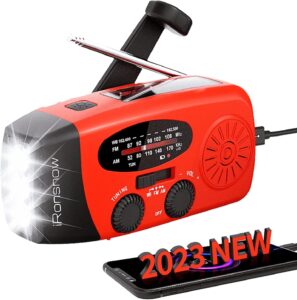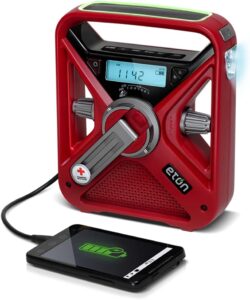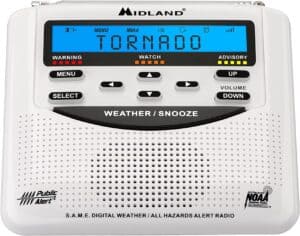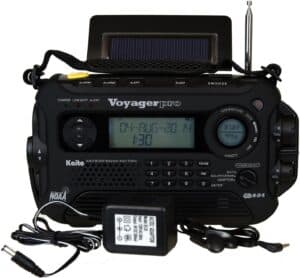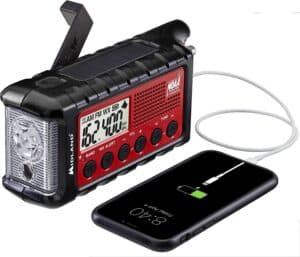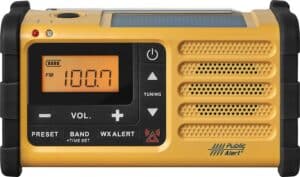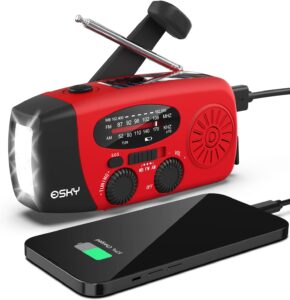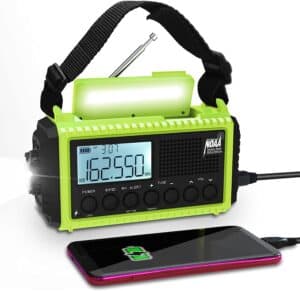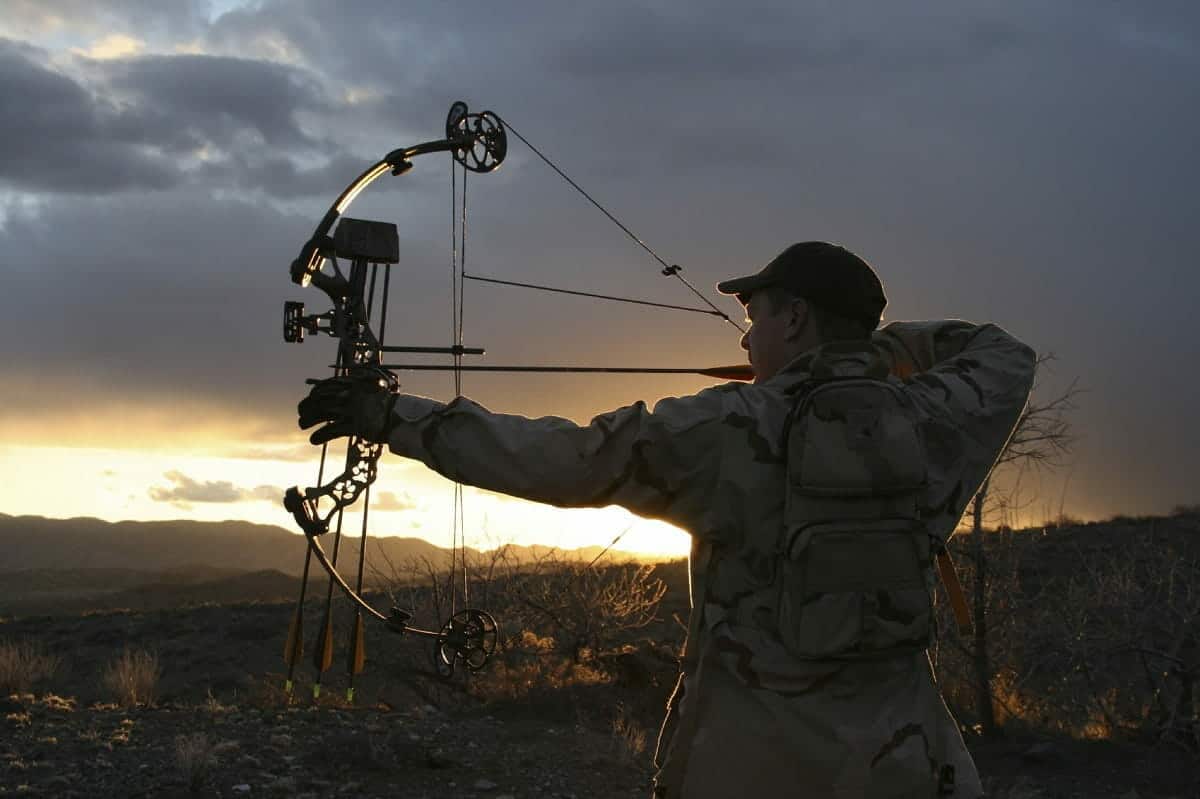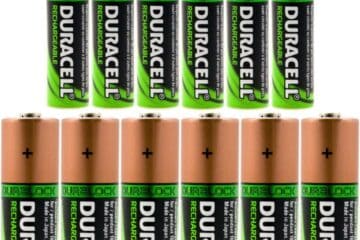When things go bad you don’t want to be in the dark. It’s never a good feeling to be unaware of whether a storm will get worse before it gets better or to feel unsure about the possibility of rescue arriving before your situation gets worse.
An emergency radio will help you stay connected to the latest news and updates even when the Internet is down or the power is out. It can be your last line for receiving critical, life-saving information in an emergency situation.
The most basic purpose of emergency radios is to provide a functional means of receiving AM and FM broadcasts in the event of a power outage or isolation from civilization. These radios typically operate on minimal or renewable power sources, such as batteries or solar power (1).
In this article, we will break down our list of the 9 Best Emergency Radios to help you make a selection.
1. Kaito KA500 5-Way Powered Emergency Radio
Perfect for all types of emergencies and natural disasters, the Kaito KA500 is outfit with a high-quality, AC-type brushless generator and a solar panel that can power the unit itself and also charges internal batteries.
This radio weighs 1.8 pounds and receives broadcasts from AM, FM, shortwave, and NOAA weather stations. It also features seven pre-programmed weather channels and the unit’s solar panel actually tilts toward the sun to maximize energy intake throughout the day.
2. iRonsnow Solar Emergency NOAA Weather Radio
Designed specifically to help you survive hurricanes and snowstorms, this emergency radio is lightweight, portable, and effective. This iRonsnow radio is just five inches in length, weighs less than a half-pound, and offers a 3-LED flashlight to help you see in the dark.
It features three charging options, solar, hand crank, and via micro USB. The rechargeable 1000mAh battery ensures that this radio will have power when you need it and micro USB capability means it can also serve as a cell phone charger when other power is unavailable.
3. The American Red Cross FRX3 Hand Crank Radio
Manufactured by Eton (2), the American Red Cross Radio is a portable and useful option for solid radio reception in an emergency. It receives AM, FM, and weather band alerts and features an LED flashlight and emergency beacon.
This radio offers multiple power options, including rechargeable batteries, a hand crank, solar power, and AAA batteries. It’s also capable of charging smartphones via USB port so you can make an emergency call when needed.
4. Midland WR120/WR120EZ Radio 
This emergency radio from Midland may resemble a standard bedside alarm clock, but with S.A.M.E. programming, this clock will only sound an alarm when specific counties are threatened, ensuring that you don’t begin emergency preparations for no reason.
The WR120/WR120EZ receives 7 NOAA weather channels with the most up-to-date information on floods, tornadoes, thunderstorms, and other weather and non-weather warnings. It also offers a 25-country memory system, 90-decibel siren, flashing LED warning systems, and built-in clock with alarm and snooze functions.
5. Kaito Voyager Pro KA600 Digital Solar Radio
Another model from Kaito, the Voyager Pro is perfect for situations when getting a quality signal is of absolute importance and you want the ability to perform your own assessments of weather and the environment.
It features four tuning methods, including manual, direct digit entry, ATS, and memory tuning with 335 memories for easy access to favorite stations. It also boasts a back-lit digital display, calendar, alarm clock with dual settings, sleep timer, thermometer, and humidity meter.
6. Midland ER310- Emergency Crank Radio
VERSATILE POWER OPTIONS – The ER310 boasts multiple sustainable power sources, ensuring your radio stays charged and ready for use. You can recharge it via the Solar Panel, Hand Crank, or the Rechargeable 2600 mAh Battery.
SOLAR PANEL – Easily replenish the internal lithium-ion battery by harnessing direct sunlight with the Solar Panel.
HAND CRANK – Don’t worry about power outages or being away from a power source. Utilize the Hand Crank to recharge the radio manually.
RECHARGEABLE 2600 mAh BATTERY – The included rechargeable and replaceable battery offers a long lifespan, providing an impressive 32 hours of radio operation.
BACKUP POWER SOLUTION – For added convenience, the ER310 can also be powered by 6 “AA” Batteries (Not Included) as a reliable backup power solution.
EMERGENCY FLASHLIGHT – Equipped with a versatile SOS FLASHLIGHT BEACON, which flashes Morse code in emergency scenarios, and a Bright CREE LED (130 Lumens) that serves as a signaling tool for help.
ADJUSTABLE BRIGHTNESS – Tailor the flashlight’s brightness to your needs. Choose between the Low brightness setting to conserve battery life or the High brightness setting for maximum illumination.
NOAA WEATHER SCAN + ALERT – Stay informed and prepared with the ER310’s NOAA Weather Scan feature, automatically scanning through 7 available weather (WX) band channels. It locks onto the strongest weather channel to alert you of severe weather updates. Additionally, the NOAA Weather Alert function sounds an alarm to indicate potential severe weather in your area. Plus, enjoy access to AM/FM radio channels for entertainment and information.
7. Sangean MMR-88 Radio
This Public Alert Certified (3) Weather Alert Radio from Sangean is primed with a variety of emergency features and is designed to make finding the information you need during severe weather or a natural disaster as simple as possible.
The MMR-88 features 19 pre-set channels that can be a mix of AM and FM stations and a DSP Digital AM/FM/WX tuner. It is chargeable by hand crank, USB, or solar power and boasts a 90-minute automatic shut-off feature to save battery if left unattended.
8. Esky Emergency Radio
This upgraded emergency radio is an excellent hands-free option to keep handy during the next severe weather or even a more routine power outage. It’s durable, water-resistant, and lighter than a paperback book!
Esky has designed this radio to charge via USB docks, a solar panel, or via hand crank. It receives AM, FM, and NOAA weather transmissions to deliver the latest weather and new updates and the included flashlight offers 140 lumens of bright light to help you see in the dark.
9.Emergency Radio Raynic 5000
The Raynic 5000 is an Automatic NOAA Weather Alert Radio with a large HD LCD display. It automatically scans for emergency and weather alerts, alerting users when any warning is issued. The radio offers 6-way charging options, including a built-in rechargeable backup battery, ensuring constant access to weather alerts. It also features an emergency SOS alarm and a bright flashlight and reading lamp for use during power outages. The portable and water-resistant design makes it easy to carry on outdoor adventures, and a headphone jack allows for nighttime listening without disturbing others. This weather radio is a crucial tool for staying prepared and safe during severe weather events.
–
Buyer’s Guide
The United States’ Emergency Alert System (EAS) is a national public warning system that requires broadcasters, cable television systems, wireless cable systems, satellite digital audio radio service (SDARS) providers, and direct broadcast satellite (DBS) providers to provide the President with communications capability to address the American people within 10 minutes during a national emergency (4).
As you can see, the EAS is designed to deliver critical emergency information through a variety of channels. Keeping a quality emergency radio on hand will give you access to that information when the Internet, satellite television, and cable systems are down.
There are a variety of emergency radios to choose from. Sorting through your options means considering a few critical factors, including battery life, range and tuning, ease of operation, size and weight, and price.
Battery Life
Running out of battery is the last thing you need when your only source of information is an emergency radio. Many radios offer multiple means of charging and re-charging for this exact reason.
Keeping an emergency radio with a hand crank charging option is always a great idea because it can essentially function on ‘human power’. While solar panel charging sounds great, the effectiveness of this option can be minimal if you’re waiting out a prolonged storm without access to sunlight.
Battery operated radios are also a great option, provided you keep a decent amount of back up batteries handy. The bottom line is that you don’t want to rely on a radio that only charges through an external source. More charging options is always better.
Range and Tuning
A radio that has excellent battery life only goes so far. If you can’t tune in to a decent enough signal so that you can actually hear information being broadcasted, your emergency radio won’t be worth much.
You want a radio that offers a decent range to receive transmissions and, ideally, multiple tuning options. A basic essential in an emergency radio is the ability to receive AM radio. This is because all NOAA alerts are sent via AM radio and, in the case of a severe emergency, local FM stations may not continue to broadcast.
Ease of Operation
While many expensive radios will dazzle with many bells and whistles, you ultimately want an emergency radio that is easy to use. Since you’ll typically only be using it on an infrequent basis, you don’t want to be struggling to figure out your radio when you should be listening to the information it can provide.
To this end, digital tuning is much easier than analog tuning for many users. That being said, analog tuning can provide a bit more flexibility to obtain those harder to reach signals if the reception is really spotty.
Size and Weight
Size and weight are two additional factors to consider. Larger radios are easier to locate and operate in the dark, but it can also be handy to have a radio that fits in your pocket while you’re rummaging around the garage for those extra batteries.
If you’re potentially going to be taking an emergency radio on the go during an evacuation situation, for example, you’ll want something that’s light and portable, but also useful. You’ll primarily want to receive urgent weather and news alerts and be able to tune to a variety of transmissions on the move.
On the other hand, if the primary purpose for your emergency radio will be to connect to the outside world during periodic power outages, you might be able to afford a larger model with more features.
Price
Price is often the deciding factor in any purchase decision. For reference, the most expensive emergency radio on Amazon is priced over $650 while the most affordable option is available for less than $20.
The radios listed above range from under $20 to $80. When deciding which emergency radio to purchase, it’s important to focus on the essentials. Ultimately, there are a number of additional features that are nice, but at the end of the day, you want a radio that will have power and receive emergency updates when you need them most.
Frequently Asked Questions
The U.S. EAS warning system has been in place since 1997 (5). In the past 20 years, the system has delivered critical information and alerts to millions of Americans and continues to be regularly tested.
While emergency alerts are now integrated into many smartphones, we can’t always count on wireless service and power availability. Let’s examine a few of the most frequently asked questions about emergency radios and the emergency alert system.
What is ‘All Hazards’ and do you need it?
NOAA Weather Radio (NWR) broadcasts National Weather Service (NWS) warnings, watches, forecasts, and other non-weather related hazard information 24 hours a day, 7 days a week.
During emergencies, NWS forecasters interrupt routine broadcasts and send a special tone that activates local weather radios. ‘All Hazards’-equipped weather radios will then sound an alert to give you immediate information about a life-threatening situation.
What do you do if your reception is poor?
First of all, check to see if an NWR station covers your county while you still have Internet access (6). Typically, the range for NWR reception is roughly 40 miles from the transmitter but many things can affect reception quality.
For example, large bodies of salt water actually increase reception range a great deal and reception is generally better at higher elevations. On the other hand, forests, deserts, hills, and mountains tend to reduce reception and, in cities, steel and concrete can hinder reception.
Can you explain the S.A.M.E. technology in some emergency radios?
S.A.M.E. stands for ‘Specific Area Message Encoding.’ It is a digital protocol or code used to send a 1050 Hz warning alarm tone to radios equipped to receive and decode such messages. Radios equipped with S.A.M.E. technology will receive the code, decode it, activate the alarm tone to get your attention, and then display the message being broadcast. Many emergency radios with this technology can be programmed to receive codes from up to 30 different nearby counties.
Summary
Emergency radios are essential to keep you connected. Receiving the most up-to-date news and weather information in an emergency can have a huge impact on the decisions you make to keep yourself and your family safe. We hope that this article has helped you find an emergency radio that’s right for you!

